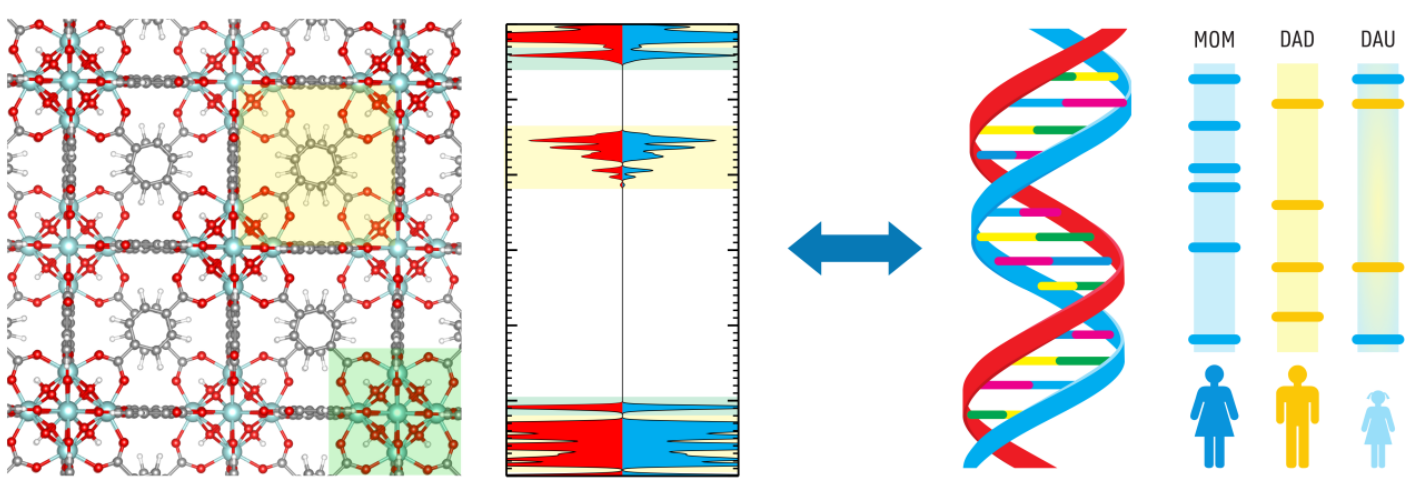Heredity in materials science: unravelling the electronic quantum genome
Heredity in materials science: unravelling the electronic quantum genome
Promotor(en): K. Lejaeghere /19MAT03 / Solid-state physicsWe are uniquely defined by our genome. Depending on the presence of different genes, it determines how we look and how we act. In the same way, materials are characterized by their electronic structure. The positions of the electronic energy bands (“quantum genes”) provide a unique identification of a crystalline material, and as these bands change, so do the properties of the material. A close agreement in the electronic genome is therefore expected to lead to very similar mechanical, magnetic or other properties: the materials “phenotype”.
There is also a second parallel between the human genome and the electronic structure of a solid-state material: both can be transferred to offspring. Indeed, just like parts of the genome of both parents are used to build the genome of the child, the electronic genome of crystals A en B is linked to that of multicomponent compound AB. An excellent example are modular materials, in which the isolated building blocks can be distinguished very easily, and which show electronic contributions from each of these individual entities (see figure).

The concept of an electronic quantum genome has barely been explored yet. Whereas traditional genomics are well underway in charting the genome of plants and animals alike, pinpointing the role of the different genetic variations, the connection between electronic structure and other materials properties remains poorly understood. A pioneering study from 2015 showed that their was a link between the electronic quantum genome and properties such as superconductivity, for example [1], but failed to provide insight into which features actually played a role in this process. Machine learning may offer the necessary answers.
Also the question of heredity is far from being resolved. Although it is one thing to recognize contributions from “parent” building blocks, we do not know yet how this transfer of quantum genes actually occurs and how mutations of the quantum genome affect the materials phenotype. Here a dedicated study is needed as well.
Goal
This thesis aims to shed new light on the concept of the electronic quantum genome by means of a twofold objective:
(1) identifying particular electronic structure features (“genes”) that correlate strongly with a broad set of energetic, mechanical and electronic materials properties (“phenotype”)
(2) investigating heredity between related structures by linking compositional changes to quantum genetic ones, eventually leading to a better understanding of what features endow a material with a given quality
You will start from existing databases of electronic structures and materials properties, obtained using quantum physical simulations (self-compiled databases, MaterialsProject, ...). However, when necessary, we have sufficient in-house expertise to guide you to create a (small) dedicated database of your own. You can then screen these databases for important correlations, allowing you to identify those features that have the highest predictive power for materials properties such as lattice parameter, hardness or charge carrier mobility. In addition, it is also possible to construct models that predict this materials phenotype without direct access to the underlying features (genes) that are used. Several high-performance python packages are available to perform such tasks (scikit-learn, pytorch, ...), varying from the more straightforward principal component analysis (PCA) to more intricate techniques such as (deep) neural networks. You will be coached in the use of python-based machine learning from the start of your thesis.
An important aspect in the analysis of quantum genomes is processing electronic structures. How do you define how much two electronic structures differ? This will be an essential question to solve in combination with the machine learning part. Should you compare point by point or is a binning approach the way to go, representing the electronic structure in terms of a histogram? Or does a more continuous criterion provide a better resolution?
Based on your metric that compares electronic structures and by using it in machine learning techniques, we might be able to usher in a new era of materials genomics.
Aspects
Master of Science in Engineering Physics: This thesis subject is closely related to the following clusters of elective courses: MODELLING, MATERIALS and NANO. Physics aspects: based on insights into the quantum physics of solids and their electronic structure; engineering aspects: application to the properties of materials, use of machine learning
- Study programmeMaster of Science in Engineering Physics [EMPHYS], Master of Science in Physics and Astronomy [CMFYST]ClustersFor Engineering Physics students, this thesis is closely related to the cluster(s) MODELLING, MATERIALS, NANOKeywordselectronic band structure, machine learning, materials scienceReferences
[1] O. Isayev et al., 'Materials Cartography: Representing and Mining Materials Space Using Structural and Electronic Fingerprints', Chem. Mater. 27, 735-743 (2015). http://dx.doi.org/10.1021/cm503507h
